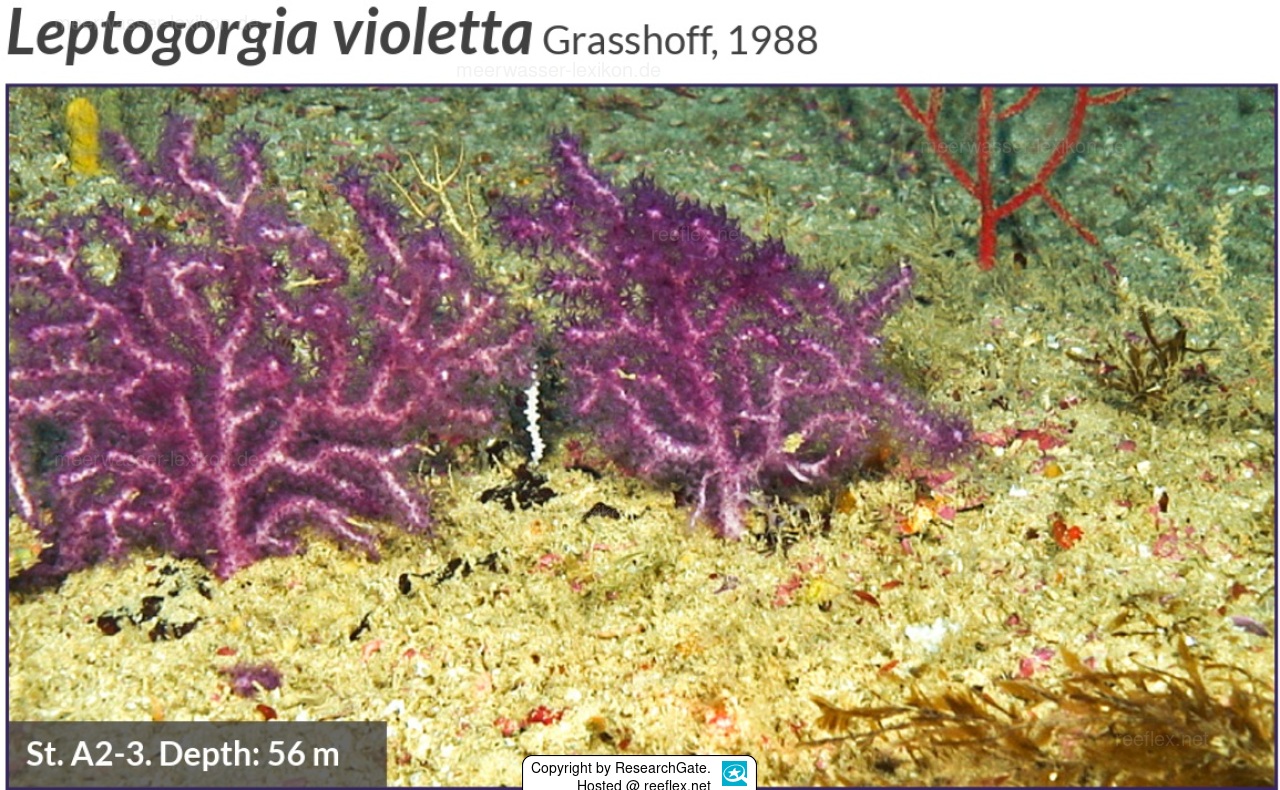Info
Leptogorgia violetta is a small, sparsely to densely branching gorgonian with thick polyps.
The coloration of this Leptogorgia species varies greatly, with variants occurring in violet, lemon yellow, ochre yellow with violet branch tips, and orange-red.
Recommendation - the coral should be kept in a species-specific tank.
Feeding
Gorgonians do not have zooxanthellae and do not live off light. Azooxanthellate gorgonians do not host symbiotic algae that produce nutrients and energy through photosynthesis.
The pumps should be switched off before feeding. In order for the gorgonian to survive in the aquarium, each individual polyp must be fed sufficiently, i.e. daily or 3-4 times a week. Without feeding, the gorgonian will not survive in the aquarium. The polyps need a certain amount of time to absorb the food (granules or dust food (Ultramarin, Cyclop Eeze) or frozen food (lobster eggs, mysis)). If shrimp and fish are present, they will try to steal the food, so it is essential to feed these cohabitants beforehand.
Newly introduced gorgonian sticks can be stimulated with a liquid food, e.g., PolypLab Polyp, to encourage the individual polyps to open. Only then can feeding be carried out.
The better the individual polyps take up the food provided, the better the growth and reproduction rates will be.
Azooxanthellate corals eat suspensions, marine snow, microplankton, and other organic matter, which is their natural food.
The azooxanthellate coral needs a continuous ocean current to wash in the necessary food, the detailed composition of which is unknown.
Divers and snorkelers will surely have admired this gem in shallow water zones.
Literature reference:
Loulidi, Ali & Buhl-Mortensen, Lene & Rhinane, Hassan & Jilali, Bensbai & Zidane, Hakima & Houssa, Rachida. (2025).
Coral habitat fauna of northwest Africa: A photographic guide to taxa identification
Shallow-water gorgonian forests along the Moroccan Atlantic Coast.
Coral Reefs. 1-22. 10.1007/s00338-025-02661-6.
(CC BY 4.0: https://creativecommons.org/licenses/by/4.0/legalcode.en).
The coloration of this Leptogorgia species varies greatly, with variants occurring in violet, lemon yellow, ochre yellow with violet branch tips, and orange-red.
Recommendation - the coral should be kept in a species-specific tank.
Feeding
Gorgonians do not have zooxanthellae and do not live off light. Azooxanthellate gorgonians do not host symbiotic algae that produce nutrients and energy through photosynthesis.
The pumps should be switched off before feeding. In order for the gorgonian to survive in the aquarium, each individual polyp must be fed sufficiently, i.e. daily or 3-4 times a week. Without feeding, the gorgonian will not survive in the aquarium. The polyps need a certain amount of time to absorb the food (granules or dust food (Ultramarin, Cyclop Eeze) or frozen food (lobster eggs, mysis)). If shrimp and fish are present, they will try to steal the food, so it is essential to feed these cohabitants beforehand.
Newly introduced gorgonian sticks can be stimulated with a liquid food, e.g., PolypLab Polyp, to encourage the individual polyps to open. Only then can feeding be carried out.
The better the individual polyps take up the food provided, the better the growth and reproduction rates will be.
Azooxanthellate corals eat suspensions, marine snow, microplankton, and other organic matter, which is their natural food.
The azooxanthellate coral needs a continuous ocean current to wash in the necessary food, the detailed composition of which is unknown.
Divers and snorkelers will surely have admired this gem in shallow water zones.
Literature reference:
Loulidi, Ali & Buhl-Mortensen, Lene & Rhinane, Hassan & Jilali, Bensbai & Zidane, Hakima & Houssa, Rachida. (2025).
Coral habitat fauna of northwest Africa: A photographic guide to taxa identification
Shallow-water gorgonian forests along the Moroccan Atlantic Coast.
Coral Reefs. 1-22. 10.1007/s00338-025-02661-6.
(CC BY 4.0: https://creativecommons.org/licenses/by/4.0/legalcode.en).







 ResearchGate
ResearchGate






























